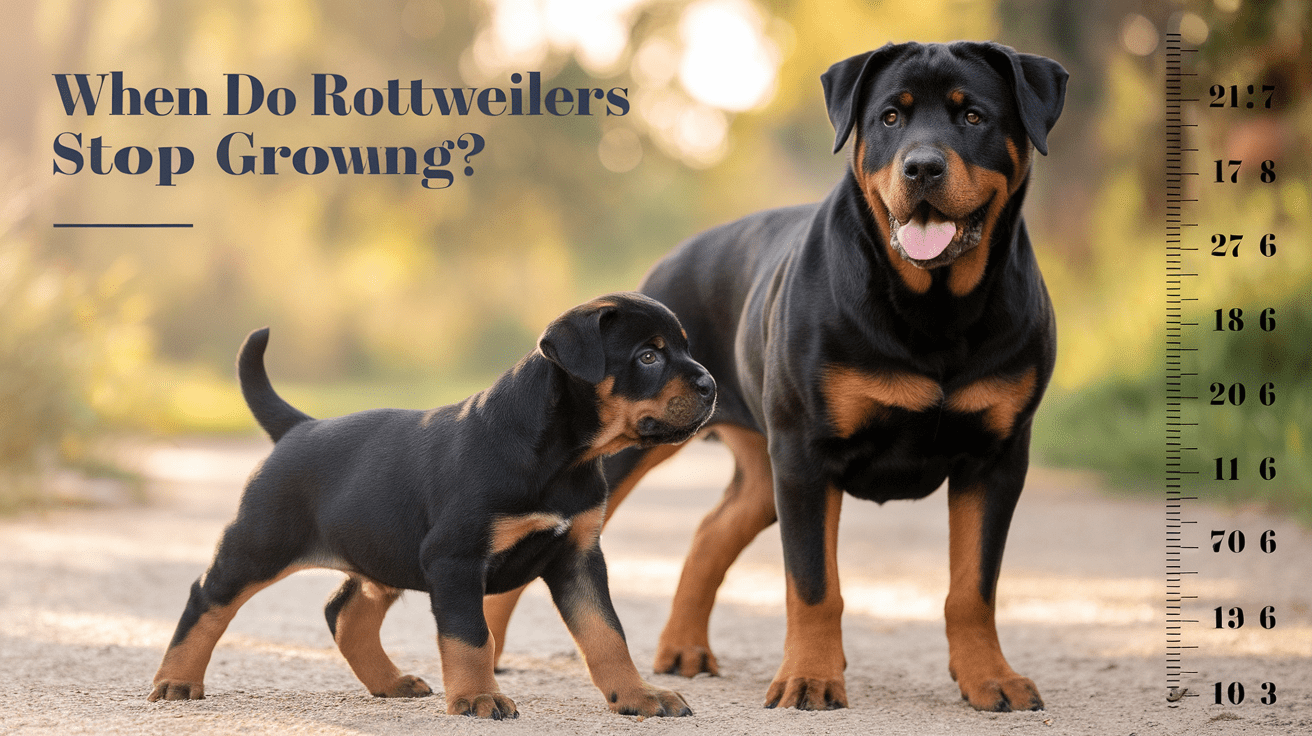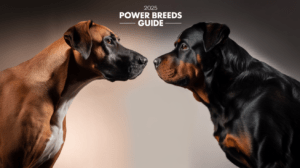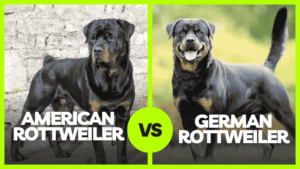When Do Rottweilers Stop Growing Key Takeaways
- ✓ Full Growth Timeline: Rottweilers typically reach their full size between 18-24 months, with males often taking longer to mature than females.
- ✓ Growth Stages: Development occurs in four main phases: rapid initial growth (0-3 months), major development (4-6 months), teenage growth spurts (7-12 months), and final maturation (12-24 months).
- ✓ Size Expectations: Adult males typically weigh 90-135 lbs and stand 24-27 inches tall, while females reach 75-110 lbs and 22-25 inches in height.
- ✓ Growth Factors: Genetics, nutrition, exercise, and overall health significantly influence a Rottweiler’s growth and development pattern.
When do Rottweilers stop growing? As a veterinarian and Rottweiler owner, I can tell you these powerful pups typically reach their full size between 18-24 months. According to a study by the AKC Canine Health Foundation, large breeds like Rottweilers have one of the longest growth periods among all dog breeds, with males often taking longer to mature than females.
Having raised three Rottweilers myself, I’ve witnessed firsthand how these adorable little bears transform into majestic guardians. Whether you’re a first-time Rottie parent wondering if your pup’s growth is on track, or you’re just curious about these magnificent dogs, understanding their complete growth timeline is crucial for ensuring healthy development.
From their rapid puppy growth spurts to their final fill-out phase, let’s explore everything you need to know about your Rottweiler’s journey to adulthood. Trust me, knowing what to expect can make the difference between a healthy, well-developed Rottweiler and one that might face growth-related challenges.
Rottweiler Growth Stages: Month by Month Breakdown
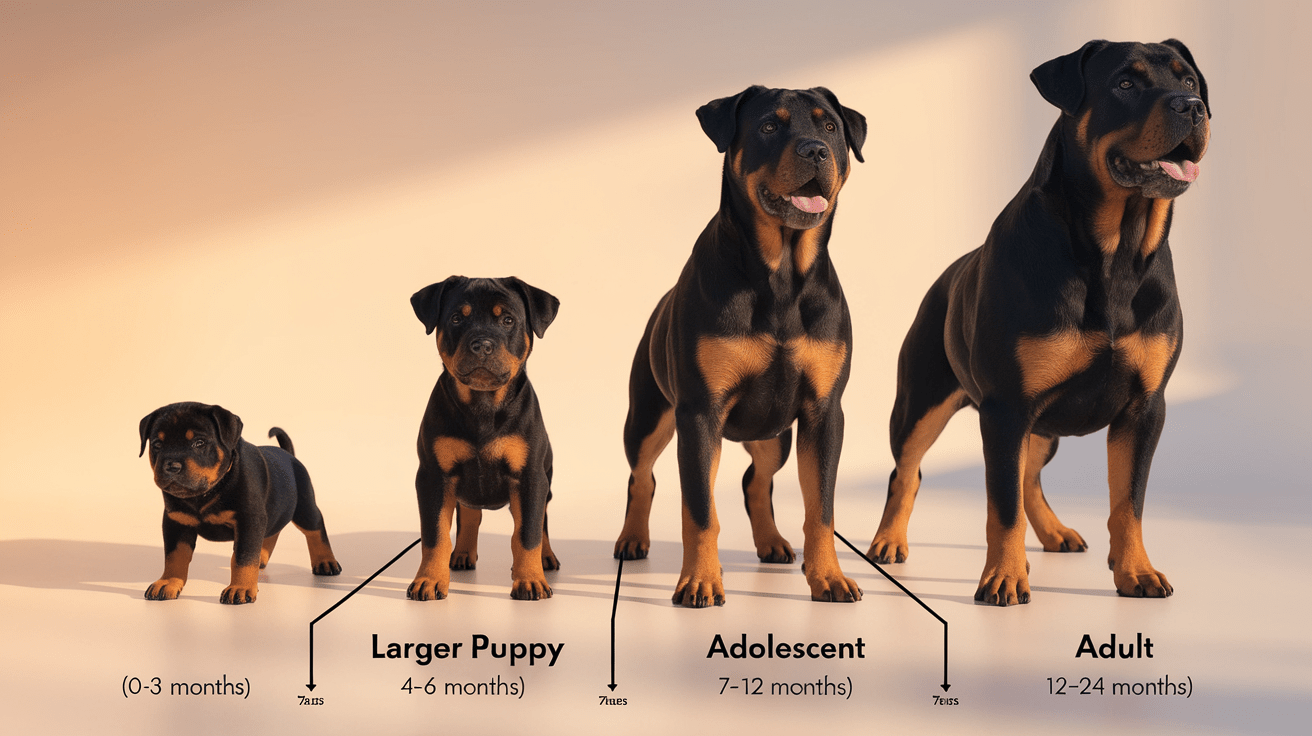
As someone who’s monitored countless Rottweiler puppies through their growth journey, I can tell you that each stage brings its own exciting developments and challenges. According to a study in Frontiers in Veterinary Science, large breeds like Rottweilers experience distinctly different growth patterns compared to smaller breeds, with critical development periods that require special attention.
Birth to 3 Months: Rapid Initial Growth
During these first three months, Rottweiler puppies experience their most dramatic growth spurt. They typically gain 2-3 pounds per week. This reminds me of my Rottie Max, who seemed to outgrow his collar every other week! Your puppy will start developing basic motor skills and begin exploring their world. This is when they’re like little sponges, absorbing everything around them.
4-6 Months: Major Development Phase
This phase is what I call the “teenage prep” period. Your Rottweiler’s growth rate begins to steady, but they’ll continue gaining significant muscle mass. You’ll notice their chest starting to broaden and their legs getting longer. During this time, it’s crucial to monitor their joint development. Proper exercise and nutrition become especially important now.
7-12 Months: Teenage Growth Spurts
Think of this as your Rottweiler’s adolescent phase. They’ll experience several growth spurts, particularly in height. Males especially will begin showing more pronounced muscular development. Watch for signs of growing pains – if your pup seems unusually reluctant to exercise or shows signs of lameness, consult your vet.
12-24 Months: Final Maturation
The final stretch! Your Rottweiler will now focus on “filling out” rather than growing taller. This is when they develop that classic Rottweiler build. Males typically take longer to reach their final size, sometimes continuing to add muscle mass until age two. During this period, your Rottie will gain their final 10-15% of body weight, primarily in muscle development.
Remember, each Rottweiler is unique, and these timelines are guidelines rather than strict rules. The key is monitoring your pup’s growth alongside regular vet check-ups to ensure they’re developing healthily.
Factors Affecting Your Rottweiler’s Growth
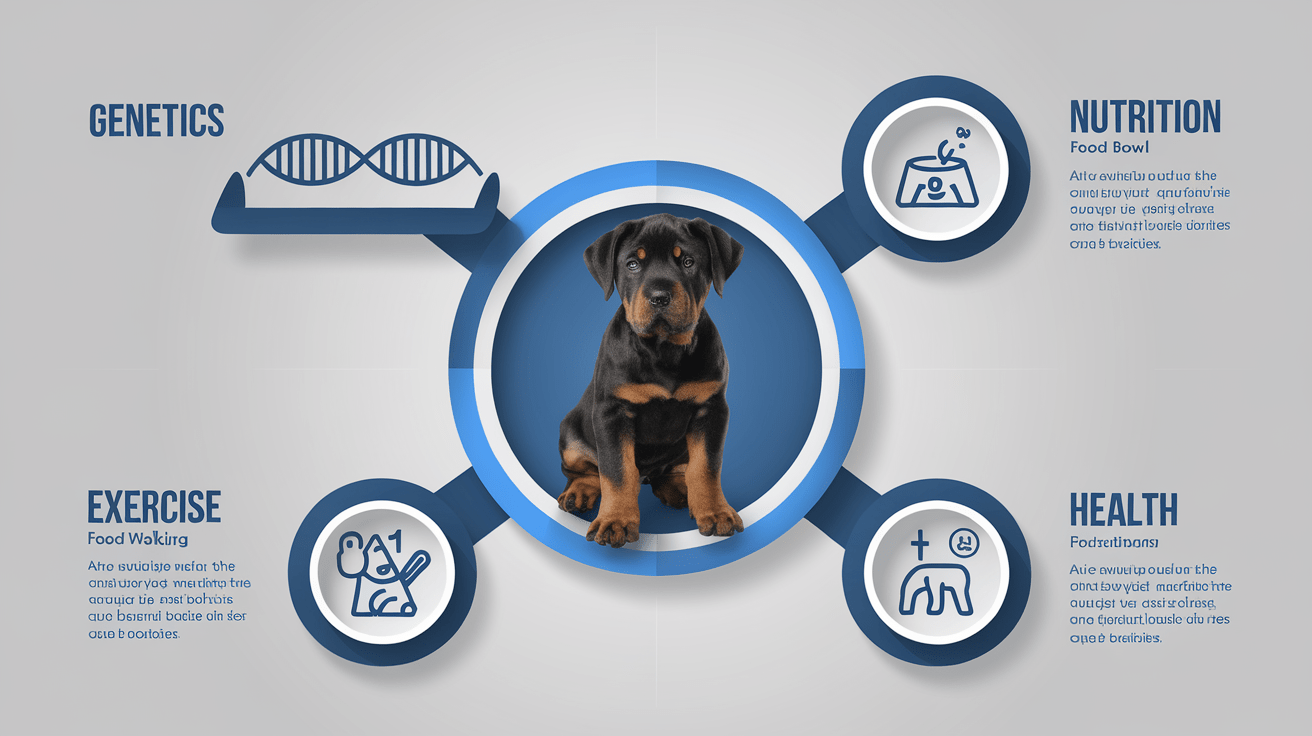
Through my years of veterinary practice and raising Rottweilers, I’ve observed that several key factors influence how these magnificent dogs develop. According to a study in The Veterinary Journal, genetics account for approximately 60% of a dog’s growth potential, but environmental factors play a crucial role in reaching that potential.
Genetics and Bloodline Impact
Your Rottweiler’s genes are like their growth blueprint. I remember when my Rottie Luna consistently tracked smaller than her littermates – it turned out both her parents were on the compact side of breed standards. While we can’t change genetics, understanding your pup’s bloodline can help set realistic growth expectations. Look for these inherited traits:
• Parent size and build• Growth rate patterns in siblings
• Known health issues in the bloodline
Nutrition and Diet Considerations
Think of nutrition as the building blocks for your Rottweiler’s growth. The right diet is absolutely crucial during development. I’ve seen countless cases where improper nutrition led to preventable growth issues. Your Rottweiler needs:
• Age-appropriate protein levels (28-30% for puppies)• Balanced calcium-to-phosphorus ratio
• Proper caloric intake to support growth without causing obesity
Exercise and Physical Activity
Exercise is like a sculptor, helping shape your Rottweiler’s developing body. However, too much or too little can cause problems. The key is finding the right balance. For instance, I advise my clients to avoid high-impact activities until their Rottie’s growth plates close, usually around 18 months. Instead, focus on:
• Controlled leash walks• Supervised free play
• Mental stimulation activities
Health Issues That May Affect Growth
As a vet, I’ve seen various health conditions impact Rottweiler growth. Early detection is crucial. Watch for signs like uneven growth, lameness, or unusual weight patterns. Common growth-affecting conditions include:
• Hip dysplasia• Osteochondritis dissecans (OCD)
• Hormonal imbalances
Remember, your Rottweiler’s growth journey is unique. Regular vet check-ups during these crucial development stages can help catch and address any concerns early. From my experience, a proactive approach to these factors often leads to the best outcomes for your growing Rottie.
How to Monitor Your Rottweiler’s Growth
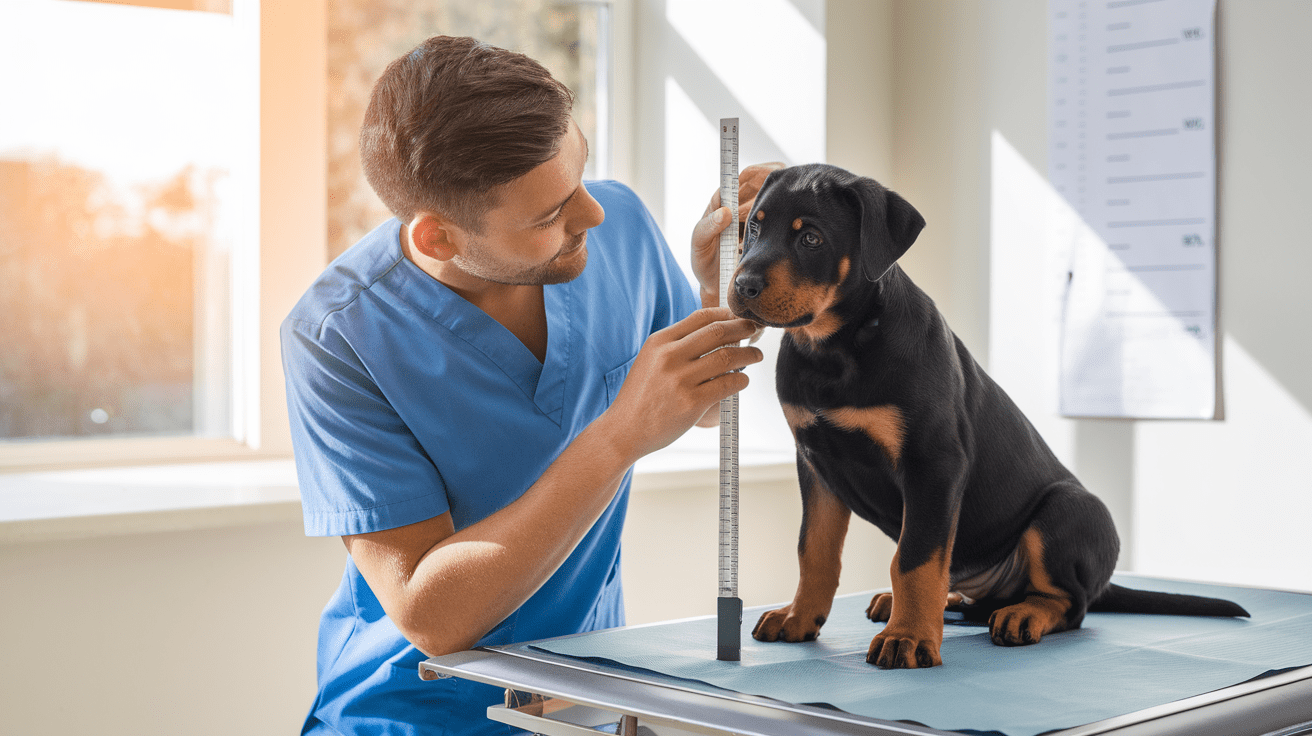
After more than a decade of treating Rottweilers, I’ve learned that monitoring growth isn’t just about checking weight – it’s about understanding the whole picture. According to a study in Veterinary Sciences, 73% of large-breed dogs who maintained proper growth monitoring during development showed fewer joint issues in adulthood.
Average Weight and Height Charts
Think of growth charts as your Rottweiler’s roadmap to maturity. When my Rottie Bruno was growing up, I tracked his progress weekly, which helped me spot a potential growth issue early on. Here are the key measurements to track:
• Weight: Males (90-135 lbs adult), Females (75-110 lbs adult)• Height: Males (24-27 inches), Females (22-25 inches)
• Chest circumference: Should steadily increase until maturity
Signs of Healthy Growth
Healthy growth isn’t just about size – it’s about quality of development. Look for these positive indicators:
• Consistent energy levels• Smooth, proportional growth
• Good muscle tone without excess fat
• Proper coat condition
• Strong, straight legs
When to Be Concerned
As both a vet and Rottweiler owner, I’ve learned to spot red flags early. If you notice any of these signs, consult your veterinarian:
• Sudden growth spurts or stops• Limping or reluctance to move
• Visible asymmetry in limbs or joints
• Significant deviation from growth charts
Tips for Supporting Proper Growth
Supporting your Rottweiler’s growth is like tending a garden – it needs consistent care and attention. These practical tips have helped countless of my clients:
• Keep a weekly growth journal with measurements and photos• Schedule regular vet check-ups (every 3-4 months during growth)
• Adjust food portions based on growth rate
• Document any concerns or changes
Remember, monitoring growth isn’t about comparing your Rottweiler to others – it’s about ensuring they’re developing healthily according to their unique pattern. I always tell my clients: “Your Rottweiler’s growth journey is as individual as they are.” Regular monitoring, combined with proper care, helps ensure your Rottie grows into a healthy, strong adult.
Frequently Asked Questions About Rottweiler Growth
Conclusion
As both a veterinarian and Rottweiler enthusiast, I can’t emphasize enough how crucial it is to understand your Rottie’s growth journey. While they typically reach their full size between 18-24 months, remember that each dog’s path to maturity is unique. The key to raising a healthy Rottweiler lies in consistent monitoring, proper nutrition, and regular veterinary care. Don’t rush their development – these powerful dogs need time to grow into their magnificent adult form. Whether you’re dealing with a tiny pup or a gangly teenager, focus on providing the support they need at each stage. By understanding and respecting your Rottweiler’s growth timeline, you’re setting them up for a healthy, happy life as your loyal companion. Remember, patience and attentiveness during these formative months will reward you with a well-developed, sturdy adult Rottweiler.
While monitoring your Rottweiler’s growth is crucial, it’s equally important to stay informed about potential health issues that could affect their development. For a comprehensive understanding of Rottweiler health concerns and how to prevent them, check out our detailed Rottweiler Health 101: A Guide to Common Issues & Preventative Care. This resource covers everything from genetic predispositions to preventative measures, helping you ensure your Rottweiler grows into a healthy, robust adult.


